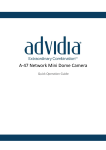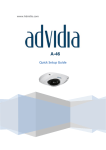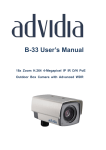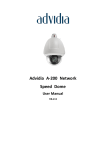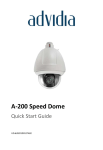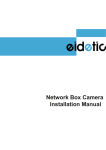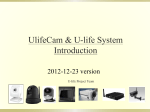Download advidia "A" Series Installation manual
Transcript
Advidia A-44 & A-54 Installation Manual Installation Manual of Network Camera Thank you for purchasing our product. If there are any questions, or requests, please do not hesitate to contact the dealer. This manual may contain inaccuracies or printing errors, and the content is subject to change without notice. The updates will be added to the new version of this manual. We will readily improve or update the products or procedures described in the manual. DISCLAIMER STATEMENT “Underwriters Laboratories Inc. (“UL”) has not tested the performance or reliability of the security or signaling aspects of this product. UL has only tested for fire, shock or casualty hazards as outlined in UL’s Standard(s) for Safety, UL60950-1. UL Certification does not cover the performance or reliability of the security or signaling aspects of this product. UL MAKES NO REPRESENTATIONS, WARRANTIES OR CERTIFICATIONS WHATSOEVER REGARDING THE PERFORMANCE OR RELIABILITY OF ANY SECURITY OR SIGNALING RELATED FUNCTIONS OF THIS PRODUCT.” 1 Installation Manual of Network Camera Safety Instruction These instructions are intended to ensure that the user can use the product correctly to avoid danger or property loss. The precaution measure is divided into ‘Warnings’ and ‘Cautions’: Warnings: Serious injury or death may be caused if any of these warnings are neglected. Cautions: Injury or equipment damage may be caused if any of these cautions are neglected. Warnings Follow these safeguards to Cautions Follow these precautions to prevent serious injury or death. prevent potential injury or material damage. Warnings: Please adopt the power adapter which can meet the safety extra low voltage (SELV) standard. And source with DC 12V or AC 24V (depending on models) according to the IEC60950-1 and Limited Power Source standard. If the product does not work properly, please contact your dealer or the nearest service center. Never attempt to disassemble the camera yourself. (We shall not assume any responsibility for problems caused by unauthorized repair or maintenance.) To reduce the risk of fire or electrical shock, do not expose this product to rain or moisture. This installation should be made by a qualified service person and should conform to all the local codes. Please install blackouts equipment into the power supply circuit for convenient supply interruption. Please make sure that the ceiling can support more than 50(N) Newton gravities if the camera is fixed to the ceiling. If the product does not work properly, please contact your dealer or the nearest service center. Never attempt to disassemble the camera yourself. (We shall not assume any responsibility for problems caused by unauthorized repair or maintenance.) 2 Installation Manual of Network Camera Notice: Make sure the power supply voltage is correct before using the camera. Do not drop the camera or subject it to physical shock. Do not touch sensor modules with fingers. If cleaning is necessary, use a clean cloth with a bit of ethanol and wipe it gently. If the camera will not be used for an extended period of time, put on the lens cap to protect the sensor from dirt. Do not aim the camera lens at the strong light such as sun or incandescent lamp. The strong light can cause fatal damage to the camera. The sensor may be burned out by a laser beam, so when any laser equipment is being used, make sure that the surface of the sensor not be exposed to the laser beam. Do not place the camera in extremely hot, cold temperatures (the operating temperature should be between -10°C ~ 60°C), dusty or damp environment, and do not expose it to high electromagnetic radiation. To avoid heat accumulation, good ventilation is required for a proper operating environment. Keep out of water and any liquid. While shipping, the camera should be packed in its original packing. Improper use or replacement of the battery may result in hazard of explosion. Please use the manufacturer recommended battery type. 3 Installation Manual of Network Camera Table of Contents CHAPTER 1 INTRODUCTION .......................................................................................................................... 1 1.1 APPLICATIONS ........................................................................................................................................ 1 1.2 PREPARATIONS ....................................................................................................................................... 1 CHAPTER 2 DOME CAMERA INSTALLATION ............................................................................................... 2 2.1 DOME CAMERA A-44/A-54 ...................................................................................................................... 2 2.1.1 Appearance Description ................................................................................................................... 2 2.1.2 Installation ......................................................................................................................................... 3 4 A-44 & A-54 Installation Manual Chapter 1 Introduction The network camera is an embedded digital surveillance product that combines the features of both traditional analog cameras and built in web server. This built-in video server provides the capability of providing real-time video stream compression, processing, video analysis and transmission simultaneously. Applying the latest processing chip and hardware platform, Advidia network cameras can be widely applied to various surveillance and image processing systems with high reliability and stability. 1.1 Applications This camera can be adopted for network video surveillance systems, e.g.: Network surveillance for over-the-counter activities in banks, ATMs, supermarkets and factories. Remote surveillance systems for nursing homes, kindergartens and schools. Artificial Intelligent access control systems . Artificial Intelligent office building/residential compounds management systems. Unguarded power station and telecommunication base station surveillance systems. Pipelining and warehousing monitoring systems. Surveillance systems for airports, railway stations, bus stops, etc. 1.2 Preparations Before you start: Verify the package contents are correct by checking the items against the packing list. Read the following contents carefully before installation. Make sure that all the related equipment is power-off during installation. Check whether the power supply is matched with your AC outlet to avoid damage. Do not place the camera in extremely hot or damp environments. To avoid over heating, proper ventilation is required. If the product does not function properly, please contact your dealer or the nearest service center. Do not disassemble the camera for repair or maintenance by yourself. 1 A-44 & A-54 Installation Manual Chapter 2 Dome Camera Installation 2.1 Dome Camera A-44, A-44IR & A-54 2.1.1 Appearance Description Camera description: Figure 2-1 Overview Table 2-1 Description No. Description 1 10M/100M self-adaptive Ethernet interface 2 INITIAL SET: Reset button 3 AUDIO OUT: Audio output interface 4 MIC IN: Audio input interface 5 D+, D-: RS-485 interface 6 1A, 1B, 2A, 2B: Alarm output interface 7 IN1, GND, IN2, GND: Alarm input interface 8 Power supply interface Note: To reset the default parameters to the camera, you need to press and hold the RESET button and power on the camera. After the power on of the camera, you must still press and hold the Reset button for about 20 seconds Camera wiring Diagram: 2 A-44 & A-54 Installation Manual Figure 2-2 Wiring Diagram 2.1.2 Installation Ceiling mounting: Note: If required, you can use a plier to remove the clip (one or two) on the side of the back box and then route cables through the opening to secure the cables on the ceiling. Figure 2-3 Remove the Clip Steps: 1. Use the screws to fix the mounting base to the ceiling; rotate the back box counterclockwise to secure it to the mounting base; use the lock screw to secure the dome camera. 3 A-44 & A-54 Installation Manual Figure 2-4 Mount the Camera 2. Loosen the set screws with the hex key (supplied) to remove the lower dome. Figure 2-5 Remove the Lower Dome 3. Connect the RCA analog video output toa monitor to view the image of the camera. Loosen the lens set screw and pan, tilt or rotate the lens to get a desired surveillance angle. Adjust the lens focus to obtain a perfect image and then tighten the lens set screw. 4 A-44 & A-54 Installation Manual Figure 2-6 Adjust the image 4. Reinstall the lower dome and tighten the screws. Figure 2-7 Reinstall the Lower Dome In-ceiling mounting: Steps: 1. Secure the mounting base to the in-ceiling mounting base with screws. 5 A-44 & A-54 Installation Manual Figure 2-8 Secure the Mounting Base 2. Push the dome camera to the in-ceiling mounting base, rotate the dome camera for 10 degrees counterclockwise and then fasten the lock screws to fix the camera. Figure 2-9 Fix the Camera 3. Cut a 176~180 mm diameter hole in the ceiling and push the dome camera with 6 A-44 & A-54 Installation Manual in-ceiling mounting base into the hole. Note: The thickness of the ceiling should be less than 30 mm. Figure 2-10 Mount the Camera 4. It is strongly recommended that you use a safety cable to secure the in-ceiling mounting base to the roof. Figure 2-11 Safety rope 5. Fasten the lock screws to secure the dome camera. 7 A-44 & A-54 Installation Manual Figure 2-12 Secure the Camera 6. Remove the lower dome and connect the RCA analog video output to a monitor to view the image of the camera. Loosen the lens set screw and pan, tilt or rotate the lens to get a desired surveillance angle. Adjust the lens focus to obtain a perfect image. Tighten the lens set screw. Figure 2-13 Adjust the Image 7. Install the trim plate with screws to finish the installation. Figure 2-14 Reinstall the Lower Dome 8














